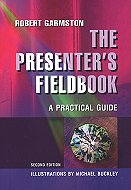The Presenter's field book: A Practical Guide
Second Edition
|
|
Robert Garmston
|

|

From the Preface
This book is written for any person who has occasion to present to others… Each in his or her own way serves as a guide for transformational learning. Here are some tidbits, tips, and treasures to add to one's presentation repertoire …..
As a people and as educators we yearn to make a great difference in our lives and positively affect our students, our families, and ourselves. We have more and richer tools with which to do this…..
Educational reforms in North America influence and have counterparts in the rest of the world. Educators here and abroad are better informed and more challenged…..
Readers of the first edition will find many new topics as well as the elaboration of earlier ideas. Among the fresh topics are speaking to groups with languages and cultures different from your own, tips and traps for PowerPoint, "stealable" examples of presentations strategies, and speaking globally. Also new is a guest chapter by Kendall Zoller, who bring state-of-the-art information on how to use nonverbal skills to lift energy, enhance memory, and improve focus and information flow. Another topic addresses the fact that everyone has a racial identity, and it gives tips for presenters on this topic…..
Some of the ideas in this book were first reported elsewhere. They have been published by the National Staff Development Council , the Association for Curriculum and Supervision Development, the Association for Training and Development or by the Education Department at California State University at Sacramento … Here they appear together - refined, updated, integrated into new material, and organized cohesively by a set of values and assumptions about adult learners and the school organizations in which educators work…..
This book takes the view that a presentation's greatest importance lies not in the skills and knowledge that participants might gain from a particular session, but in the contribution that those skills, knowledge, and attitudes make to participants' work and the broader dynamics of the work culture. Teachers' thoughts, feelings, decisions, and behaviors are influenced more by the culture of the workplace than by their skills, knowledge and prior or current training…..
|
|
